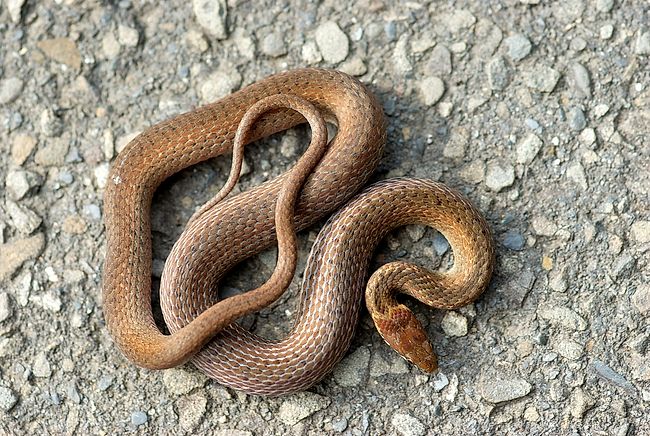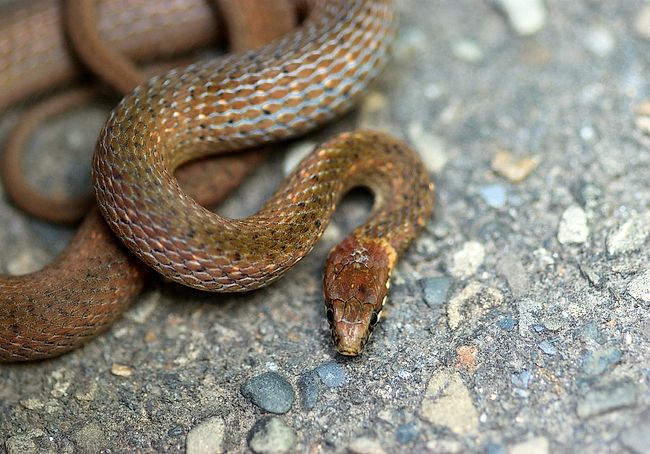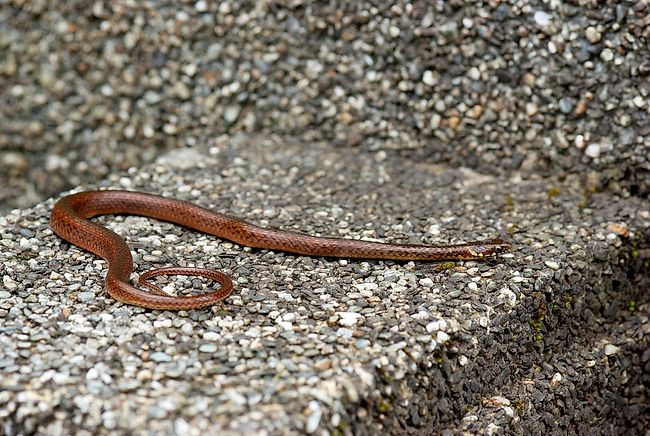Hebius sauteri
Sauter's Watersnake
梭德氏游蛇 (suo1de2shi4you2she2)
Status: Not Protected
Non-venomous
Family
Colubridae, subfamily Natricinae
Max. length
76 cm
Occurrence in Taiwan
Common throughout Taiwan, up to 1000 m altitude.
Global Distribution
Taiwan, South China (Jiangxi, Guangxi, Guangdong, Fujian, Sichuan, Hubei...), N. Vietnam.
Description
Medium to large snake; total length up to 200 cm. There are 15-27 (19-21 at mid-body and 23-27 at neck) rows of smooth and glossy scales; the dorsolateral scales are strongly oblique. Head is broad, roughly triangular and slightly distinct from neck; body is moderately heavy, slightly flattened, and may be considerably flattened when angry; tail is short. Nostrils large and conspicuous. Eye is medium-sized; iris is dark dirty yellow dappled with dark gray black to blue-black and pupil is round, jet black. There are no loreals. Tongue is dark gray to blue-black, with stem possibly lighter in color than forks. Fangs are rigid, short to medium length, and located anterior to middle of upper law. Upper head is light gray tan to dark gray-black, usually the same color as upper body and tail; sides of head are lighter in color. Individuals bearing other colors in dorsal surface, such as white, yellow or brown may be found. There may be irregular or scattered crosslines of white to light gray along upper body and a spectacle-like mark on the upper face of the expanded neck (hood); however, the designs on the hood may range from partial figures to non-symmetrical patterns. Ventral head and neck are white to light gray or light orange; there may be one pair of small dark spots followed by a dark transverse band on the ventral face of hood. The color of ventral body and tail may be white to gray, dark gray mottled with white, or blackish. The populations in different geographic regions of Taiwan reveal a unique composition of ventral coloration: the eastern population is exclusively blackish (100%), the central and southern populations are mainly white to gray (both 80%), and the proportions of blackish and white-gray morphs in the northern population are 60% and 30%, respectively. Anal scale is entire, and subcaudals are paired.
Biology & Ecology
Sauter's Water Snake (or Grass Snake), Hebius sauteri, is the serpent you're most likely to
encounter in leaf-littered drainage and roadside ditches in Taiwan and South China. Leaf litter is
home to earthworms, grubs, and other tiny moisture-loving critters, and that's what these snakes eat.
They hardly ever exceed two feet in length, have the sweetest demeanor one could hope for, and keep
the musking to a minimum - perfect training snakes for newbie herpers
and ophidiophobes alike. Apart from ditches, these cathemeral (diurnal or nocturnal) snakes also inhabit other humid environments,
such as ponds and rivers. They prey on earthworms, slugs, tadpoles, and frogs. Females produce about
5 eggs of approximately 2.5 x 1.5 cm per clutch. The juveniles tend to be very dark and round-headed,
but get lighter and more pointy-snouted with age.
Etymology
Hebius: Derived from the Japanese word "Hebi", which means "snake".
sauteri: in honor of Hans Sauter, a Taiwan-based German entomologist who collected the
type specimen for A. sauteri.
The Chinese name 梭德氏游蛇 (suo1de2shi4you2she2) means "Sauter's (梭德氏, suo1de2shi4)
water or swimming snake (游蛇, you2she2)".
Notes
The taxon name of this species follows the opinion of DAVID et al. (2007)
Further Info





























